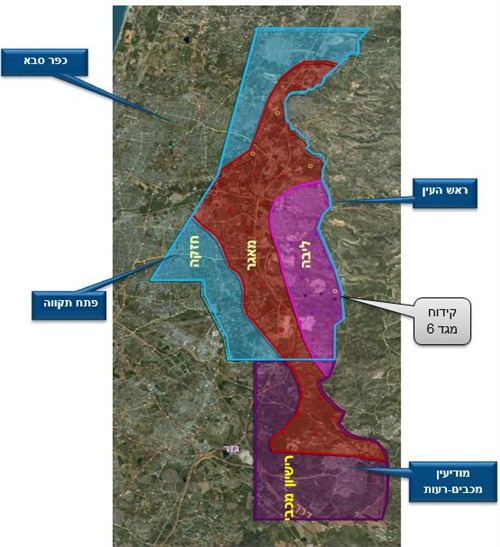Offshore/onshore Onshore Start of development 2004 | Operator Givot Olam Discovery 2004 Start of production 2010 | |
 | ||
Estimated oil in place 200 million tonnes(~ 242.5×10^ m or 1525 MMbbl) | ||
The Meged oil field is an oil field that was first discovered in the 1980s but declared to not be commercially viable at the time. In 2004, Givot Olam declared to have made it commercially viable to drill. It is one of the largest on-shore oil fields in Israel. It began production in 2010 and produces oil as well as some natural gas. Its proven oil reserves are about 1,525 million barrels (242.5×10^6 m3).
Contents
Overview
The Meged oil field is located near the towns of Kfar Saba and Rosh Ha'Ayin in Israel. It is situated close to the southern tip of the Palmyra rift system, a geological formation that extends across Syria to the northeast. Givot Olam, which owns and operates the Meged license, first announced its discovery of the Meged field in April 2004. The field spans 200 square kilometers.
In early January 2012, Givot Olam reported that the state had rejected the company's proposal to drill at Meged wells 6, 7 and 8. Later in the month Givot reported that it had obtained approval to proceed with drilling operations at Meged wells 5, 6 and 14.
Agreements
In 2010, Givot Olam sold 240 barrels of oil obtained from Meged 5 to Oil Refineries Ltd (BAZAN), an Israeli oil refining company.
During the first quarter of 2011 Givot sold NIS4.6 million worth of crude oil extracted from the Meged field to refineries.
An agreement signed between Givot Olam and Natural Gas for Israel Ltd. (GTL) in March 2012 stipulated that the former would supply natural gas to GTL from the Meged 5 well for a period of three years in exchange for $4.4 million, beginning in 2013.
Religion
Givot Olam founder Tovia Luskin was drawn to the Meged site after interpreting a geological survey of the area in 1988 as confirming a biblical passage in the Book of Deuteronomy (33:15) and its associated commentary by Rashi. According to Luskin, he visited the Lubavitcher Rebbe in New York in 1990 and received a blessing from him.
In order to accommodate Jewish religious proscriptions against performing labor on the Sabbath, in 2011 Givot Olam introduced Shabbat clocks into its production system to obviate the use of manual faucets.
Land rights
With the location of Meged Oil field close to the border between Israel and the West Bank, it is subject to a dispute over ownership rights.
Palestinians claim that Givot Olam decided that the field is commercially viable only after the creation of the Israeli West Bank barrier to the west of the field, which they claim is located within the borders of the Ramallah and al-Bireh Governorate.
According to a source in the Palestinian Authority, 80% of the Meged oil field is on land owned by Palestinians. Efraim Sneh has stated that although the oil drilling site is in Israel the oil reservoir may extend to the West Bank near the West Bank village of Rantis. Sneh suggested that cooperation between the Israeli and Palestinian sides could lead to the construction of a joint oil pipeline.
Fracking
According to reports published by Givot Olam, the methods used in determining the potential for oil extraction at some of the Meged wells involve fracking.
